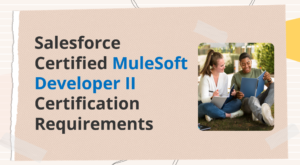Salesforce Certified MuleSoft Developer II Certification Requirements
Salesforce Certified MuleSoft Developer II certification is designed for individuals who have already obtained the Salesforce Certified MuleSoft Developer I credential and are looking to demonstrate their ability to work independently on production-ready Mule applications in a DevOps environment. The Salesforce Certified MuleSoft Developer II certification is geared towards professionals who have substantial experience with MuleSoft and Anypoint Platform. It verifies a candidate’s ability to design, build, test, debug, deploy, and manage APIs and integrations that balance critical non-functional requirements such as monitoring, performance, maintainability, reliability, and security.
Prerequisite: Salesforce Certified MuleSoft Developer I credential.

MuleSoft Developer II Exam Format
– Number of Questions: 60 multiple-choice questions and up to five non-scored questions.
– Time Allotted: 120 minutes.
– Passing Score: 70%.
– Registration Fee: US$200.
– Retake Fee: US$100.
Key Competencies Assessed
The certification exam measures the following competencies:
1. Expose Production-Ready Anypoint Platform-Managed APIs:
– Implement versioning of API artifacts.
– Configure API policies (custom or out-of-the-box).
– Implement server-side caching.
– Request API access with environment-specific scoping.
– Implement HTTP callbacks and auto-discovery.
2. Implement Maintainable and Modular Mule Applications:
– Optimize Maven build configurations.
– Automate deployment using Maven.
– Execute and implement MUnit tests.
– Build custom API policies and encapsulate common functionalities.
– Implement custom message processors.
3. Implement Monitorable Mule Applications:
– Expose health check endpoints.
– Implement effective logging strategies.
– Monitor applications and runtimes.
– Handle message correlation over HTTP.
4. Implement Performant and Reliable Mule Applications:
– Utilize ObjectStore for persistence.
– Ensure fault-tolerant and performant message passing.
– Handle HTTP status codes correctly.
– Validate messages against schemas.
– Implement parallel processing with scatter-gather.
– Implement compensating transactions.
5. Secure Data at Rest and in Transit:
– Manage secure properties.
– Handle keys and certificates.
– Ensure secure API communication with HTTPS and TLS.
– Implement authentication methods such as Basic Auth and OAuth2.
MuleSoft Developer II Preparation Tips
To excel in the Salesforce Certified MuleSoft Developer II exam, candidates should have hands-on experience with Mule applications in a real-world setting. Here are some preparation tips:
– Practical Experience: Engage in projects that require building and managing APIs using Anypoint Platform.
– Study the Objectives: Focus on the key competencies and understand the underlying concepts.
– Utilize Study Guides and Online Resources: Salesforce and MuleSoft provide comprehensive study materials, including guides, practice exams, and community forums.
– Practice Tests: Take advantage of MuleSoft Developer II practice exams to familiarize yourself with the format and identify areas needing improvement.
– Join a Study Group: Collaborating with peers can provide new insights and enhance learning.
The Salesforce Certified MuleSoft Developer II certification is a prestigious credential that validates a developer’s ability to handle complex integration challenges using MuleSoft and Anypoint Platform. Achieving this certification not only enhances a professional’s skills but also opens up advanced career opportunities in the field of enterprise integration. With a robust understanding of API management, modular application development, performance optimization, monitoring, and security, certified professionals are well-equipped to contribute to the success of their organizations’ integration projects.
